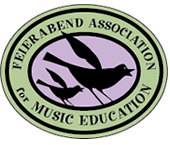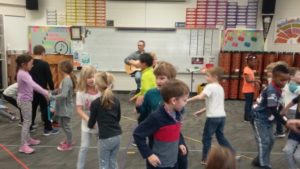by Andrew Himelick – FAME Teacher Trainer: FSM & CS
 When I started my student teaching over 25 years ago, my supervising teacher, who was trained both in Kodály and Gordon methodologies, made it clear that her expectations were for me to use my falsetto voice. Not only this, but I was expected to sing with the students whenever they sang. I taught that way for 12 years until I took a Conversational Solfege certification course with John Feierabend in 2005 and everything changed.
When I started my student teaching over 25 years ago, my supervising teacher, who was trained both in Kodály and Gordon methodologies, made it clear that her expectations were for me to use my falsetto voice. Not only this, but I was expected to sing with the students whenever they sang. I taught that way for 12 years until I took a Conversational Solfege certification course with John Feierabend in 2005 and everything changed.
During the 12 years before I took that Conversational Solfege course, though, I would often have days where my voice felt tight and tired from constantly singing and using my falsetto. Since I felt I was doing the best for my students, though, I continued. However, when Dr. Feierabend shared his, “sing for the class and not with the class” golden rule, it was like a weight had been lifted off my shoulders. He explained the importance of allowing students to hear the music rather than having them try to “split-second sing.” He gave the example of a church congregation singing an unknown hymn with an organist. The congregation is constantly trying to play “catch up” with the organist and, therefore, singing about a millisecond behind. When I taught songs by rote (where students learn a phrase at a time by echoing the teacher), I used to also sing with the students whenever they echoed. And when I would sing a song in its entirety, I was OK with the students trying to sing along. This style of “immediate imitation” was modeled and reinforced for me when I took my Orff levels.
But after John’s suggestion, I started using his approach. I did not sing with the students when they would echo back when learning a song by rote. I found the students listened better and I was better able to fully hear if they were successful learning the rhythms and melody. When I taught a whole song, I had the students only listen while they kept the beat or played a game. I would do this over a few class meetings and then eventually asked the students to sing the song. It was amazing to me how, by assimilation, they learned the whole song and then could reproduce it independently with more accuracy and expression (including dynamics and style).
Since I was no longer singing with the students, I then began to question the need to always sing in my falsetto voice. I remember John stating the research that showed the best vocal model for a child was another child’s voice. Next best was a female’s voice. Next was a man’s falsetto. And, last and worst was a man’s lower register. (Learn more regarding some of this research in a 1994 document by J. Andrew Hendley and Diane Cummings Persellin published by Texas Music Education Research: https://www.tmea.org/assets/pdf/research/Hen1994.pdf)
I was concerned that my students would not match pitch as well if I decided to change my approach based on the research. But, I went ahead and started to sing using only my lower register…even with kindergarten when they would echo fragment songs in the First Steps in Musiccurriculum. I found that as long as I had the children do vocal exploration warm-ups (i.e. slide whistle, puppets, pathway cards, etc.), before moving on to regular singing, they would stay in their head voice when they would echo me. I made sure my singing voice was not forced and full of vibrato.
So, with those changes, two things happened. First, my students became better listeners and in-tune singers. Second, I found that I was experiencing better vocal health since I was not singing as much and could sing in my lower register.
Now, with all that being said, I do sometimes jump up the octave when students are struggling with a solfege pattern or phrase of a song. I do this mainly with my older students. Even if I explain to my primary students (K-2) that I have two kinds of voices and even demonstrate the difference, when I ask them to echo my falsetto voice as I sing a pattern or a phrase of a song, many of them will try to sing even higher than they are supposed to. However, they don’t do this when I demonstrate a high vocal siren or sigh. Perhaps it is because those sirening activities don’t have certain particular pitches that must be ascertained.
So, my recommendation for other male elementary teachers is to:
- Sing for the class, not with the class
- Don’t use falsetto unless necessary
Thanks for all you do to help your students to be “tuneful, beatful and artful!”

